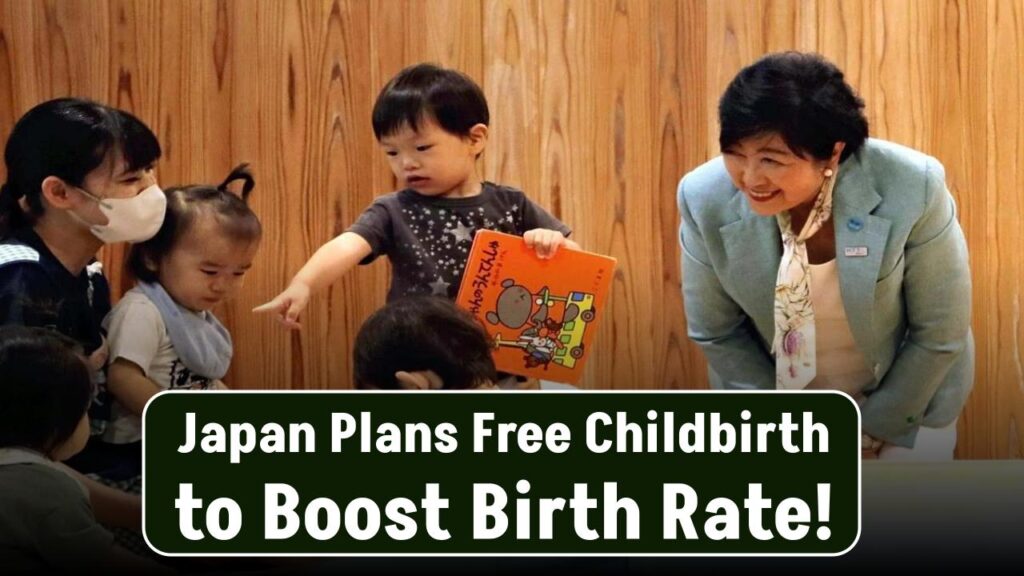Japan May Change Childbirth Laws: Japan may change childbirth laws in a major step toward reversing its declining birth rate. A new government proposal aims to make childbirth completely free under Japan’s national health insurance system — a move that could reshape family planning, reduce financial stress, and support long-term population growth.

Currently, childbirth in Japan comes with a hefty price tag. The average cost for a standard delivery is around ¥518,000 (~₹2.9 lakh or ~$3,500 USD), and unless there are medical interventions, such as a cesarean section, this cost isn’t covered by insurance. Although families receive a childbirth subsidy of up to ¥500,000, this still falls short in about 45% of cases, leaving new parents to shoulder significant expenses.
This article explains Japan’s proposed reforms, their expected impact, and what families, professionals, and policymakers need to know.
Japan May Change Childbirth Laws
Here are the essential details at a glance:
| Key Point | Details |
|---|---|
| Proposed Policy | Make standard childbirth free under national health insurance |
| Current Childbirth Cost (Avg.) | ¥518,000 (~₹2.9 lakh or ~$3,500 USD) |
| Government Subsidy per Birth | Up to ¥500,000 (falls short in 45% of cases) |
| Births in Japan (2024) | 720,998 (Lowest since records began in 1899) |
| Fertility Rate (2023) | 1.2 (Well below the replacement rate of 2.1) |
| Other Policies | Child allowances, subsidized epidurals, flexible work policies |
| Implementation Target | Fiscal Year 2026 |
| Official Source | Japan Health Ministry |
Japan’s proposal to make childbirth free nationwide marks a pivotal moment in its battle against declining birth rates. Backed by practical reforms like child allowances, work flexibility, and medical subsidies, the policy shows promise in making family life more accessible. For professionals in policy, healthcare, and economics, this is a case study worth watching. For families, it could mean a brighter, less stressful future.
Why Is Japan Taking This Step?
Japan is facing a historic demographic crisis. According to AP News, the number of births in 2024 was just 720,998 — the lowest in over 125 years.
With a fertility rate of 1.2, Japan is far below the replacement rate of 2.1, which is needed to maintain a stable population. If this trend continues, Japan’s working population will shrink drastically, threatening its economy and social welfare systems.
What Will the New Law Change?
1. Free Standard Childbirth
The most significant proposed change is to cover all childbirth-related expenses through Japan’s national health insurance. This includes costs for standard deliveries at hospitals and clinics, which are currently not insured unless complications arise.
2. Nationwide Cost Standardization
The government also aims to standardize childbirth costs across regions, addressing current disparities where costs vary significantly depending on location and facility.
According to The Independent, the new system would create a unified fee schedule, making the process fairer and more predictable for families.
Supporting Measures to Boost Birth Rates
Japan’s childbirth policy overhaul is part of a broader strategy that includes several complementary reforms:
Expanded Child Allowances
In 2024, new legislation increased monthly child allowances and parental leave benefits. The changes are set to be fully implemented by fiscal year 2026, offering families additional financial support during early child-rearing years.
Read more at Kyodo News+.
Subsidized Epidurals
To improve the birthing experience and encourage more women to consider motherhood, Tokyo now subsidizes up to ¥100,000 for epidural anesthesia during childbirth. This is especially significant in a country where epidurals have historically been less common.
Details via The Times.
Flexible Work Policies
From April 2025, Tokyo will introduce a four-day workweek for government employees. This bold policy is designed to promote work-life balance, giving parents more time and energy to raise children.
Explore more at Business Insider.
Practical Implications for Families
Here’s how these changes could benefit everyday people:
- Lower Financial Stress: With childbirth costs fully covered, families can plan for children without the financial burden.
- Equal Access Across Regions: Uniform pricing ensures that no matter where a woman gives birth, she receives the same level of financial support.
- Improved Work-Life Balance: The new workweek policies could give parents much-needed time at home.
- Pain-Free Childbirth Options: Subsidized epidurals make the experience less daunting for first-time mothers.
Expert Opinions
According to demographic experts at Newsweek, Japan’s latest moves are not just reactive, but part of a long-term demographic survival plan. Without these interventions, Japan could lose up to 30% of its population by 2100.
FAQs on Japan May Change Childbirth Laws
Q1: Will the childbirth law apply to foreign residents in Japan?
Yes, as long as they are enrolled in the national health insurance system, foreign residents should be eligible once the law is enacted.
Q2: When will the new law take effect?
The government targets fiscal year 2026. It must still pass through Japan’s legislative process and policy implementation phases.
Q3: What is Japan doing beyond childbirth cost reforms?
The country is also expanding parental leave, offering child allowances, subsidizing epidurals, and piloting shorter workweeks.
Q4: Is Japan the first country to make childbirth free?
No, countries like Sweden and France have long provided free or highly subsidized maternal healthcare. Japan is catching up with global standards.





